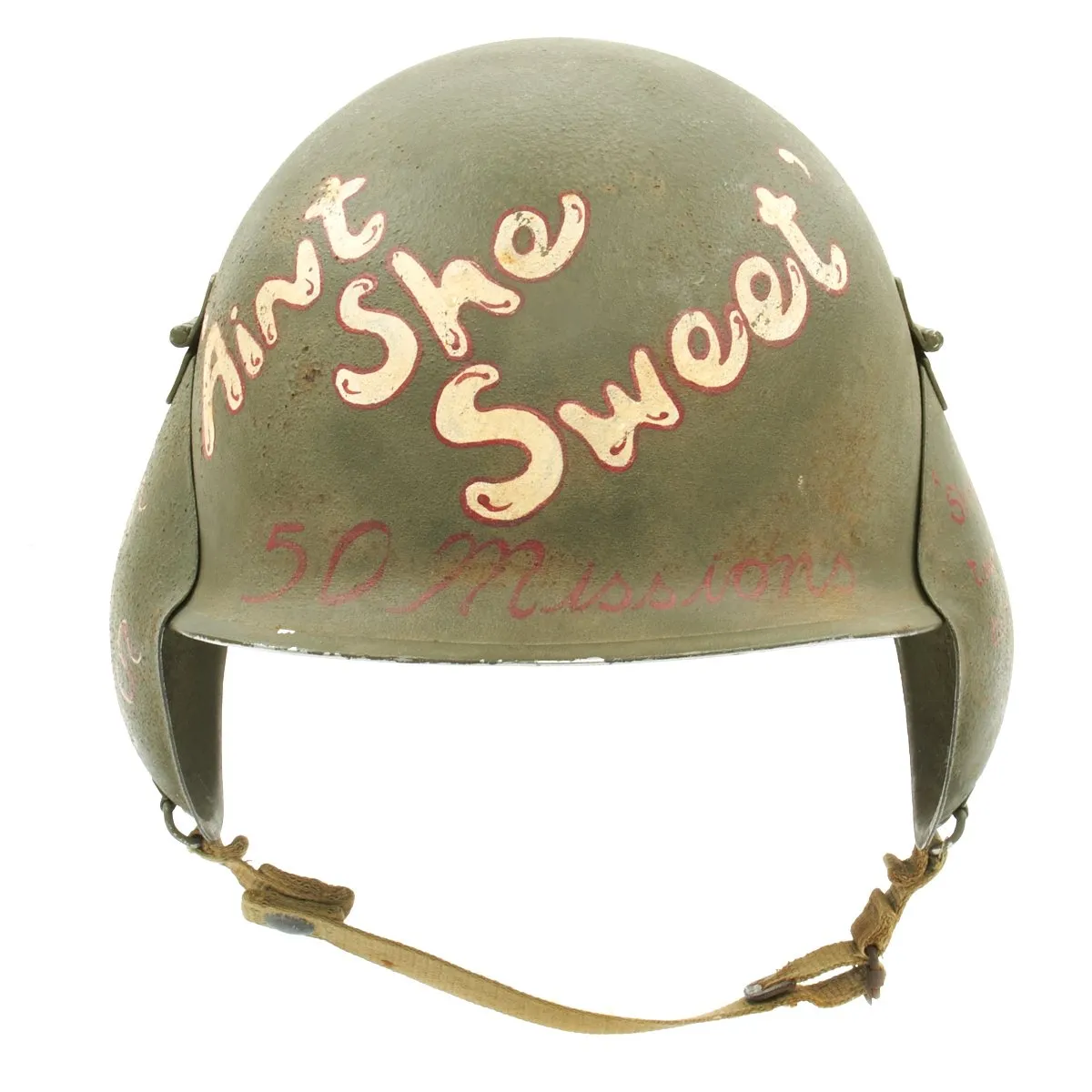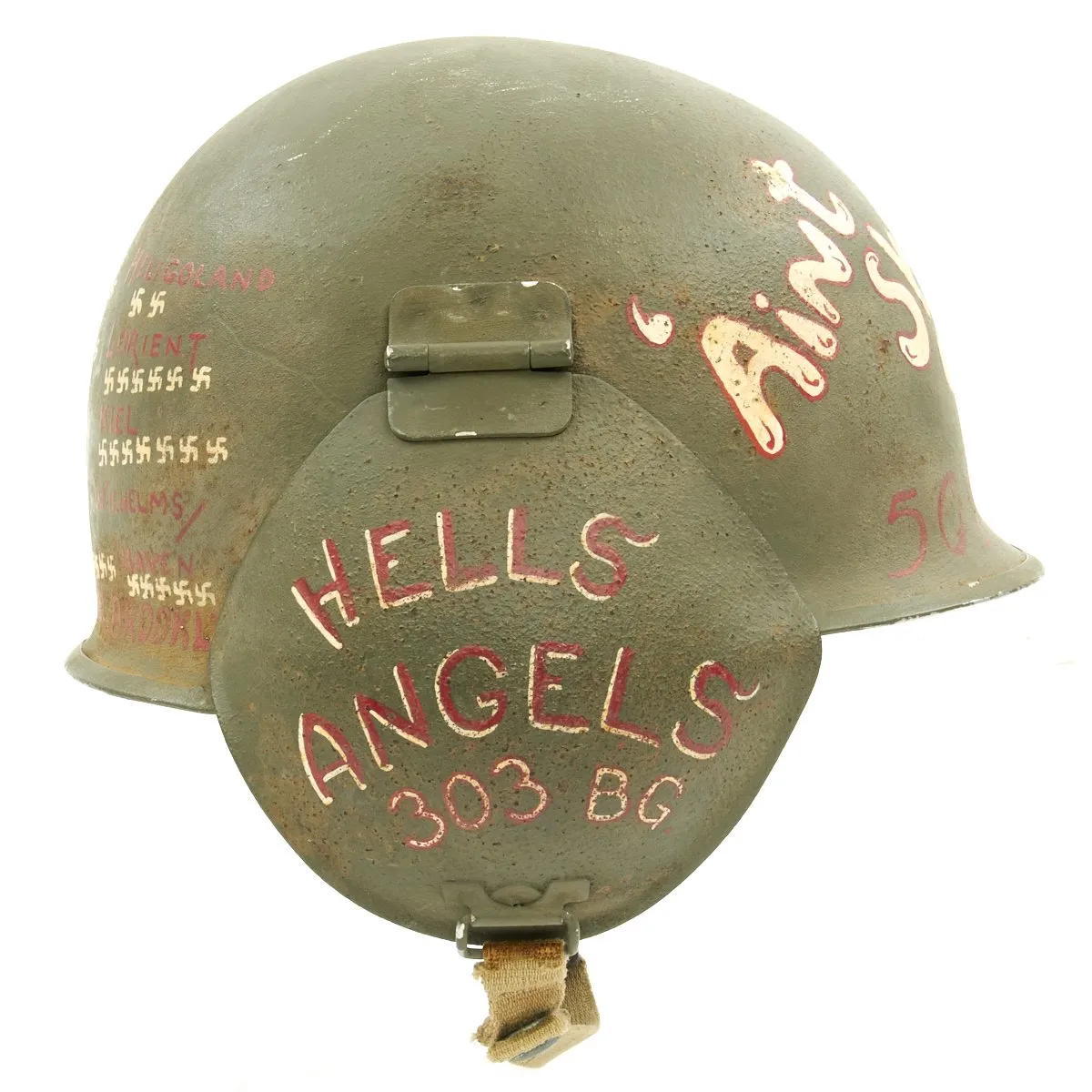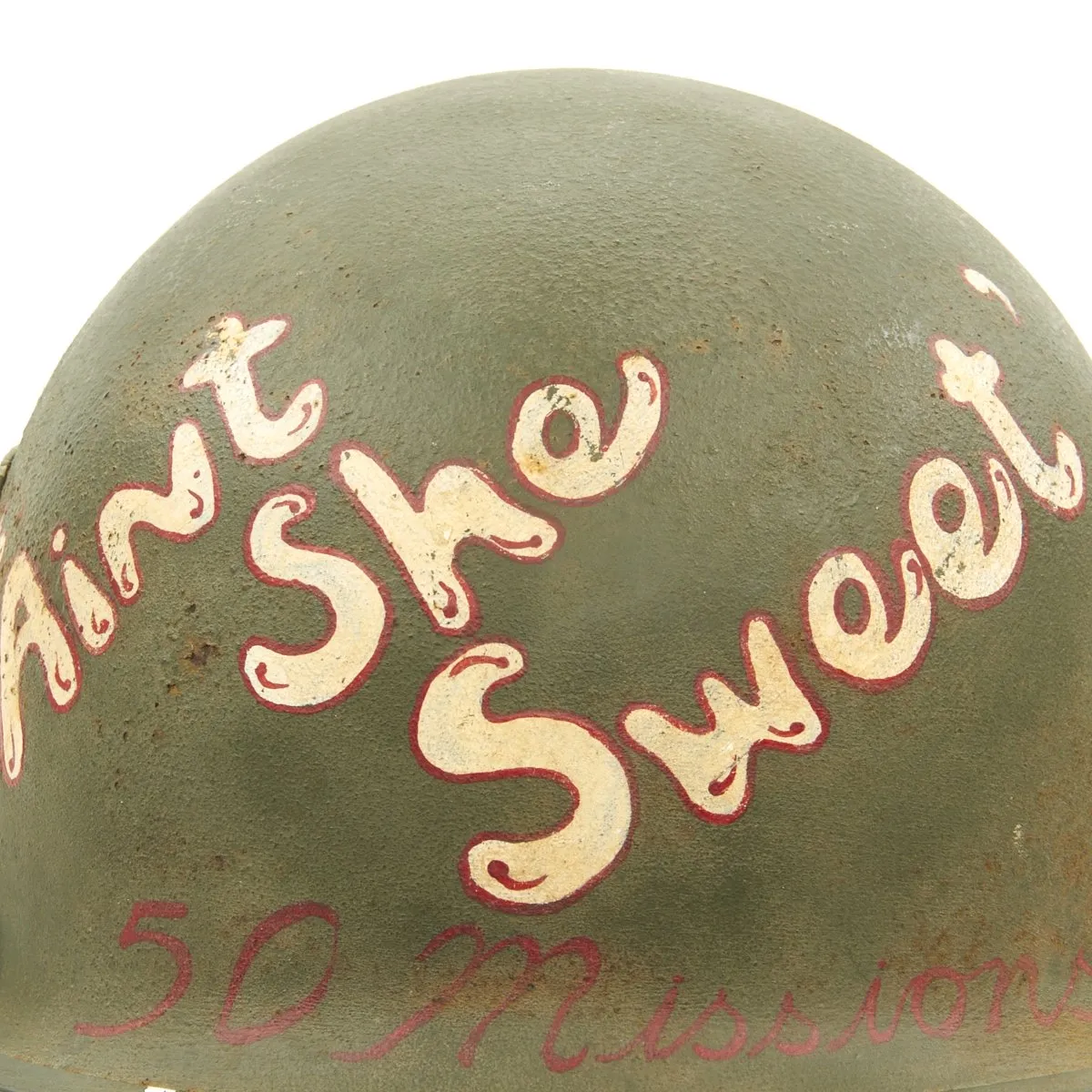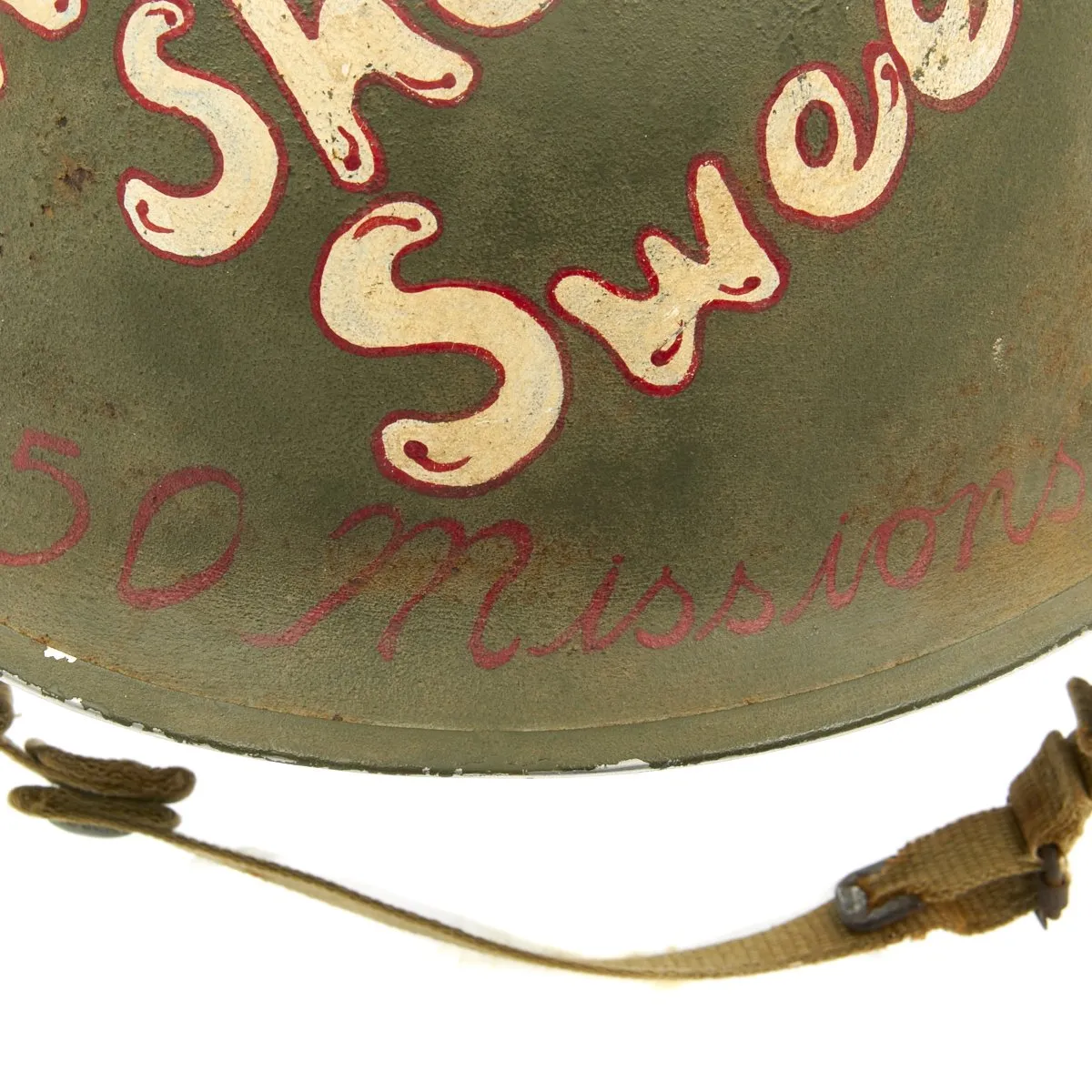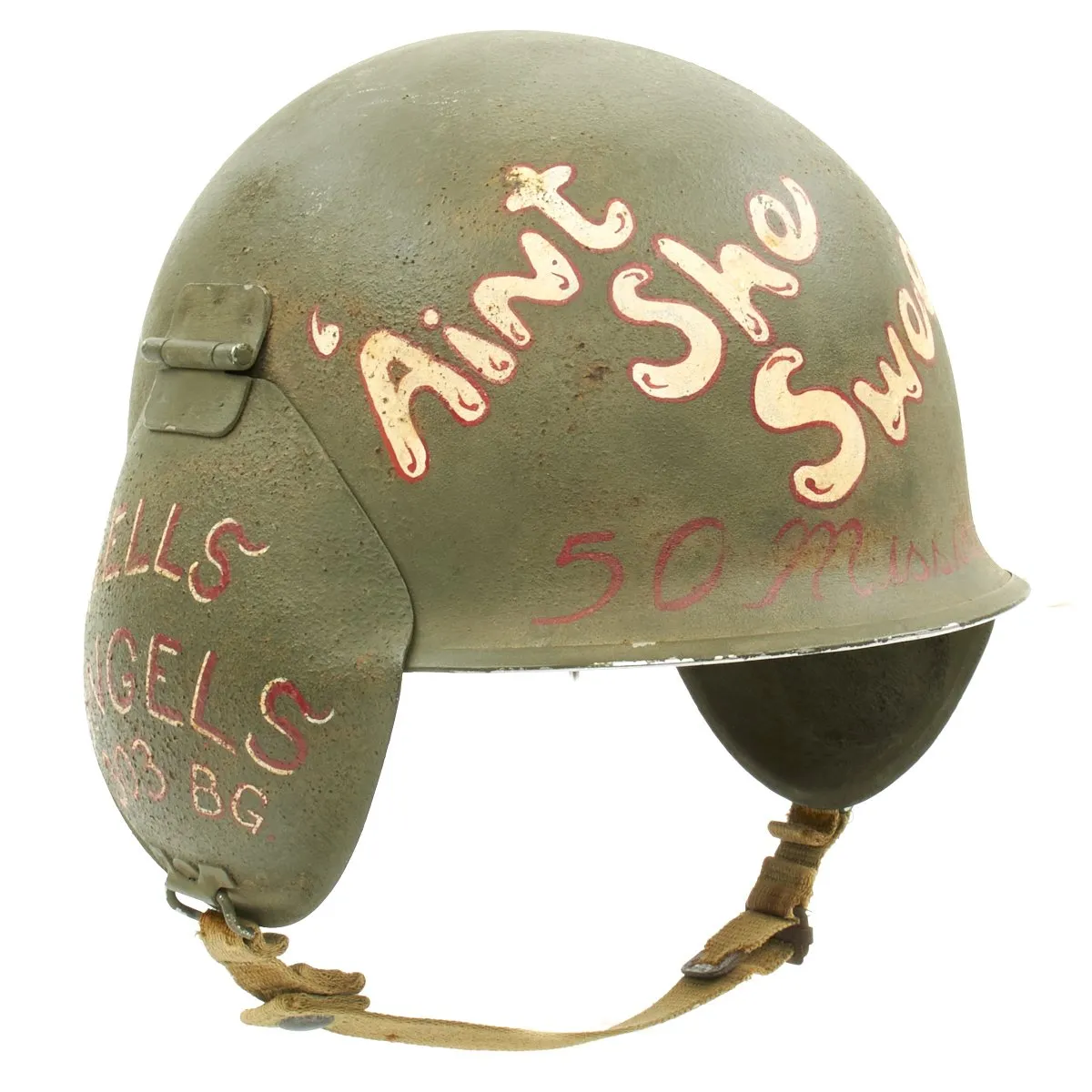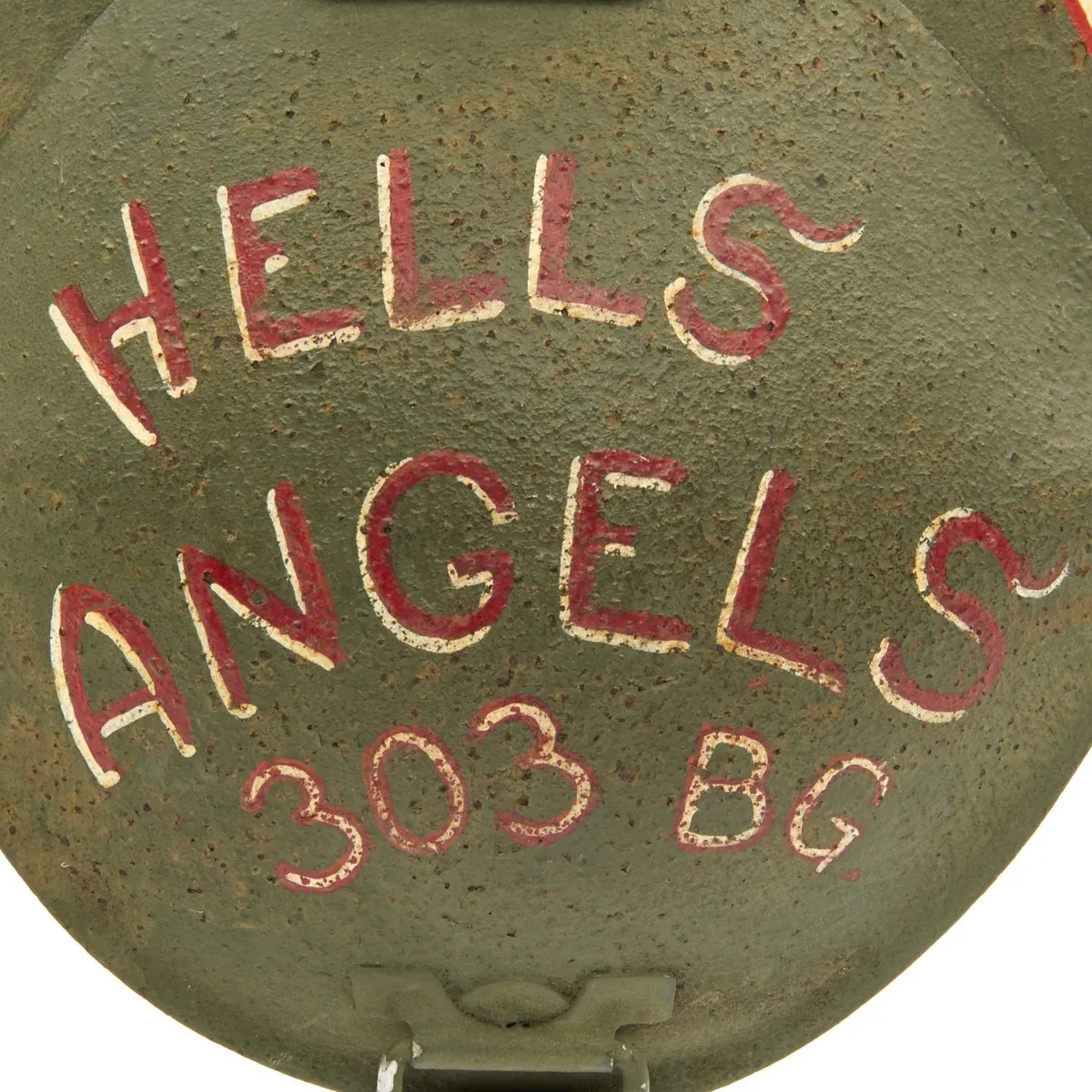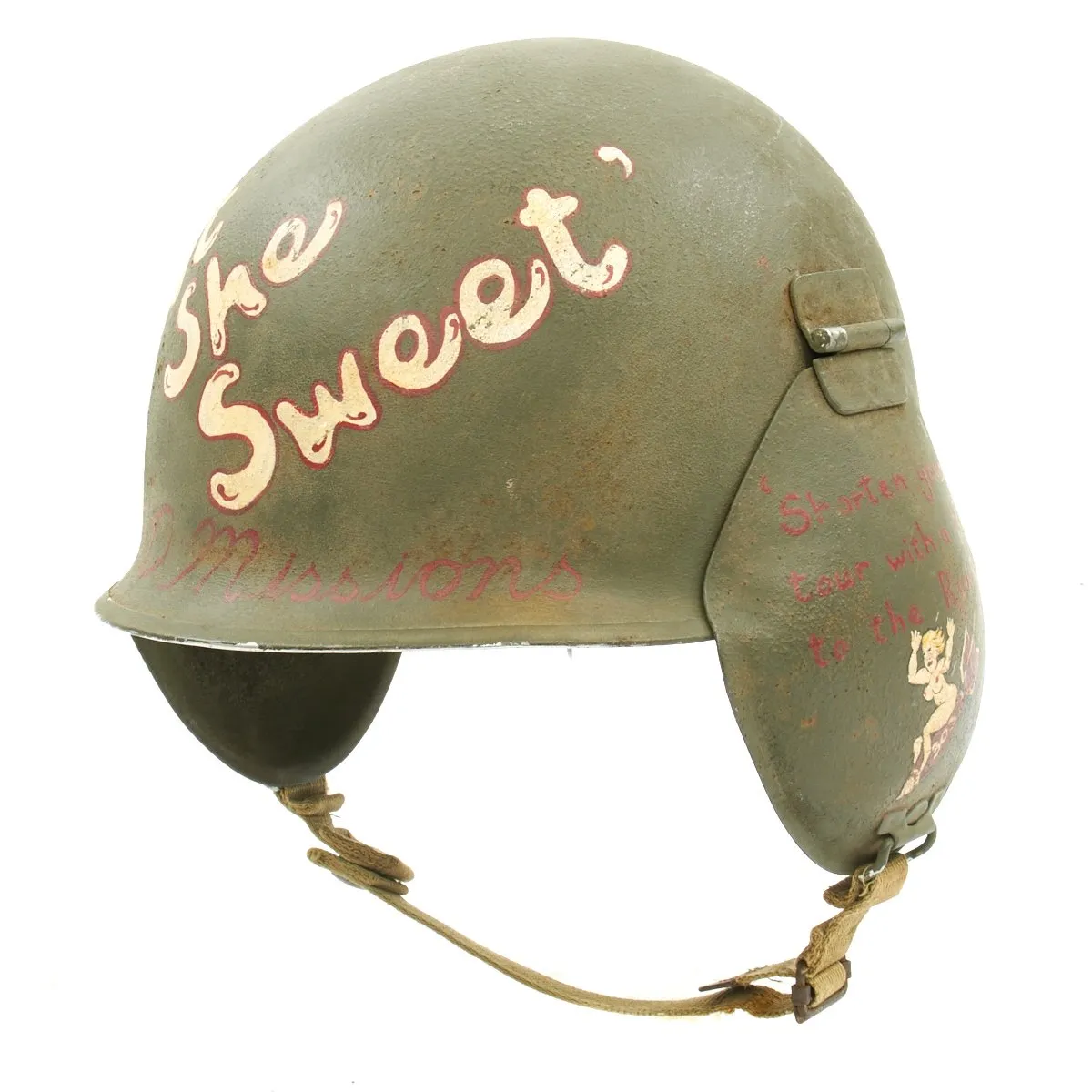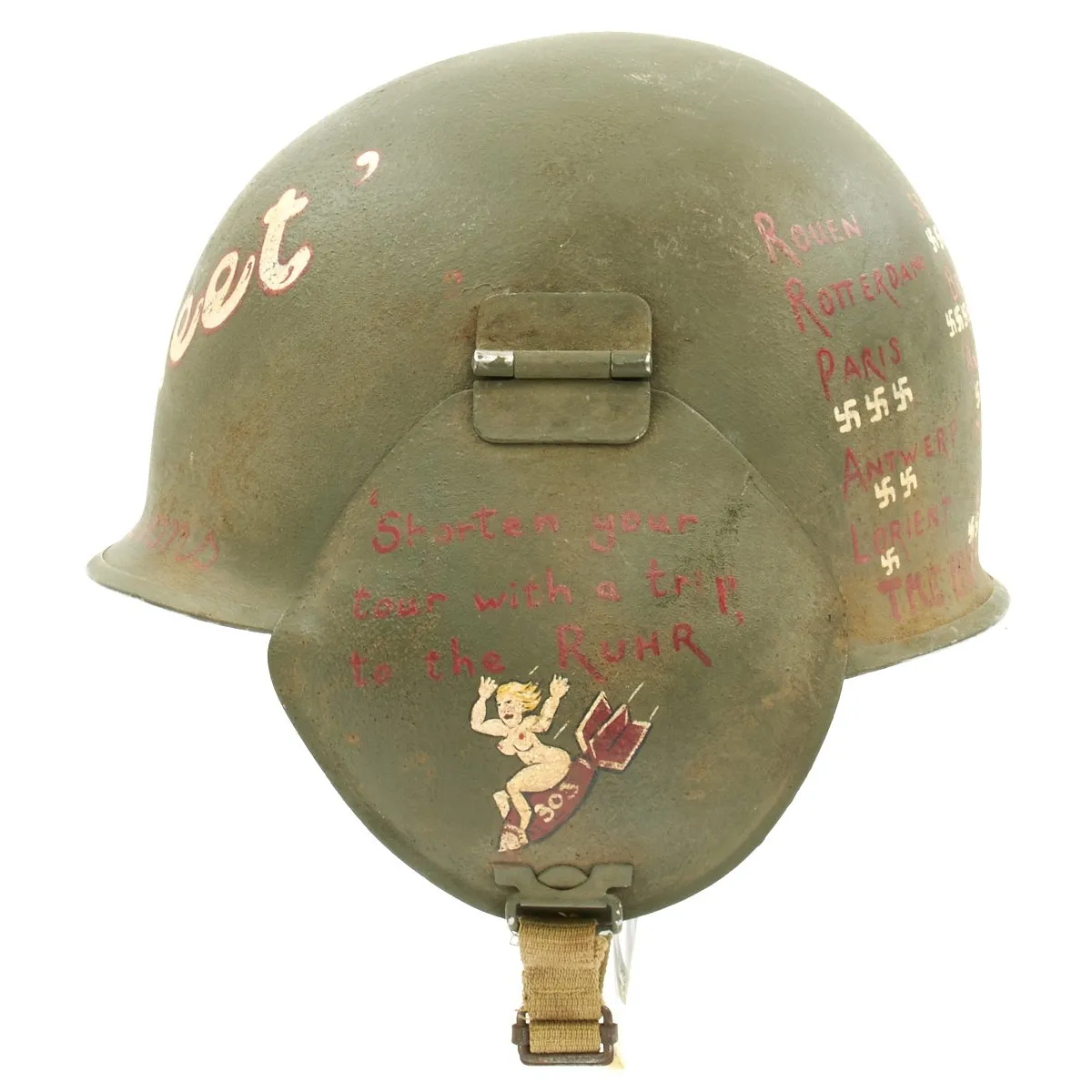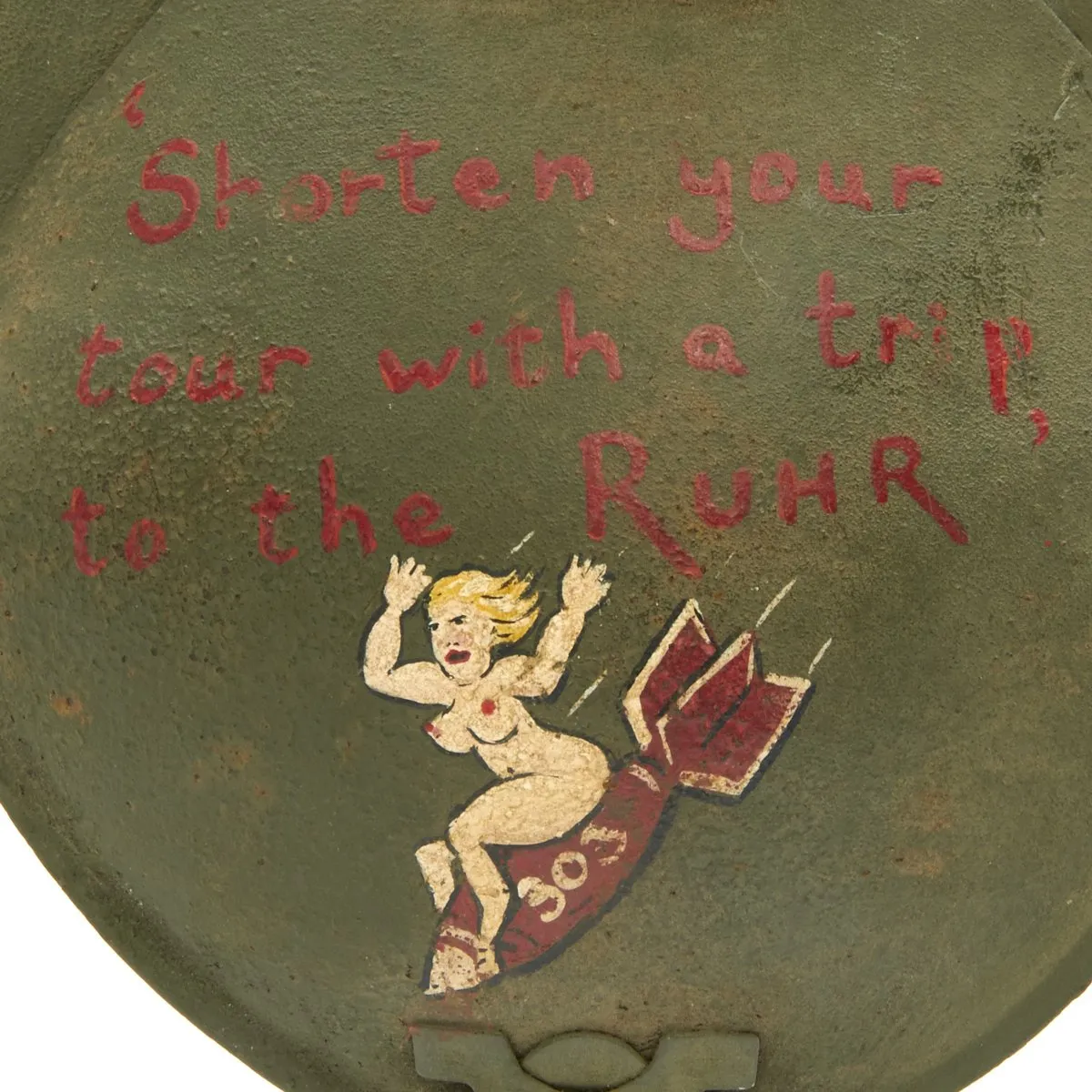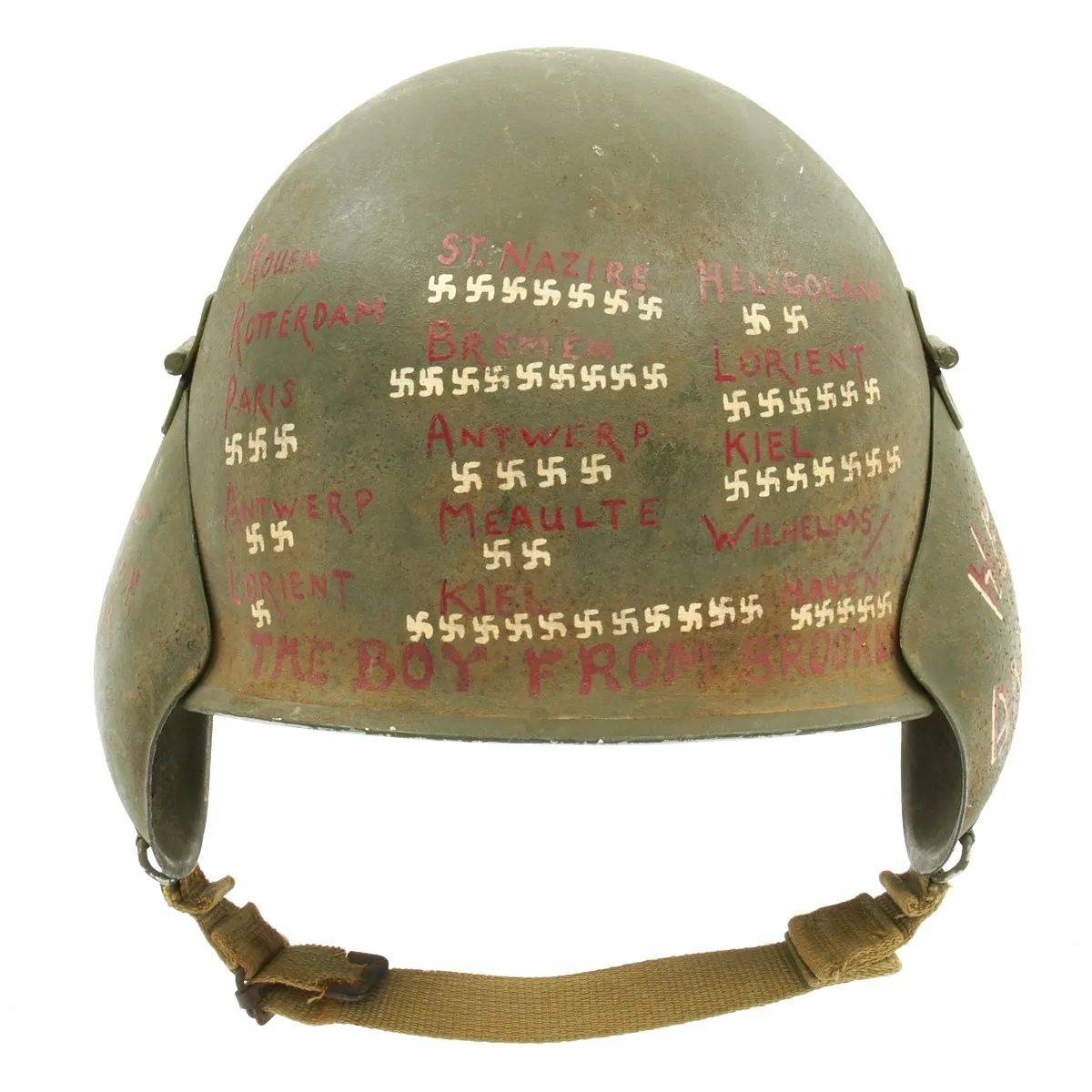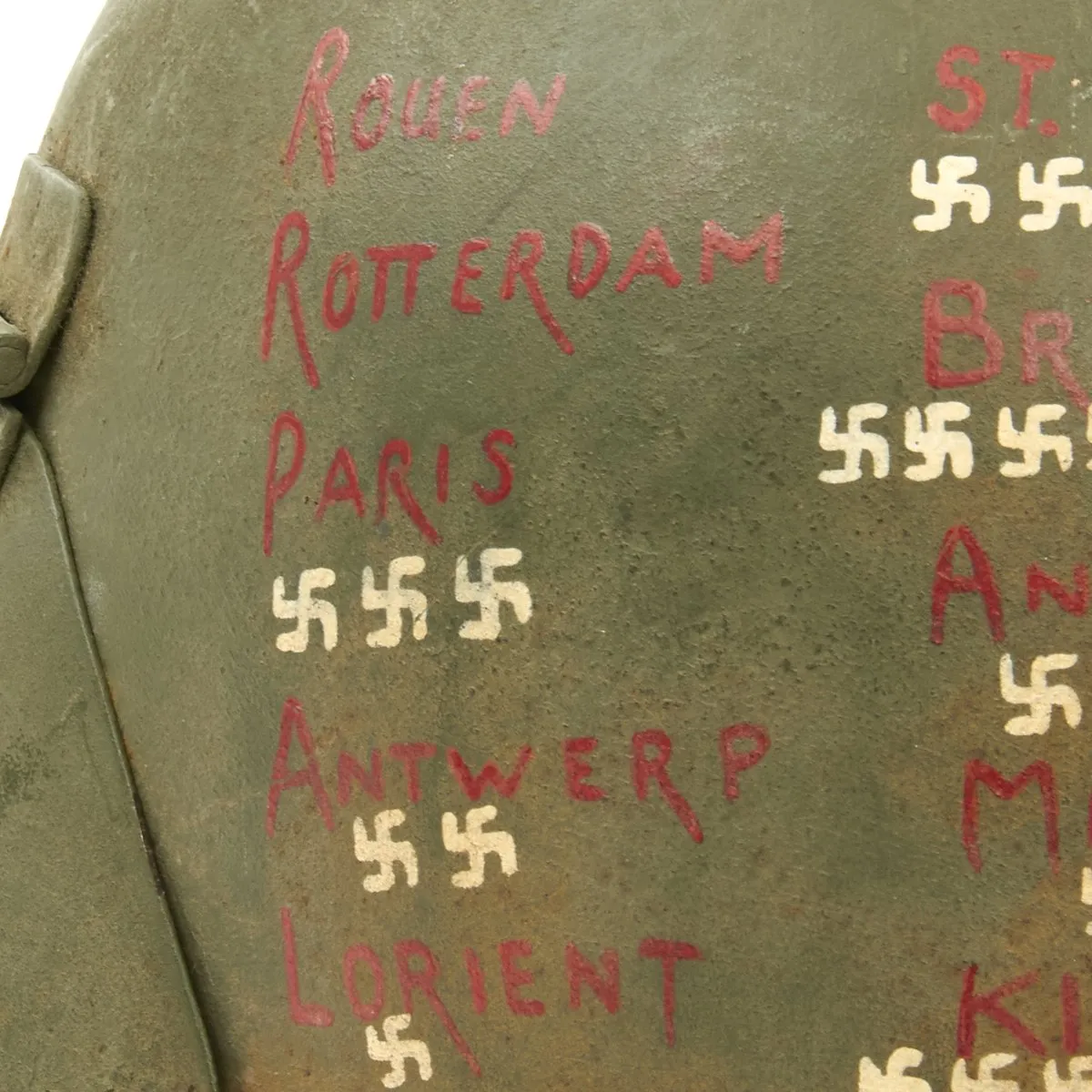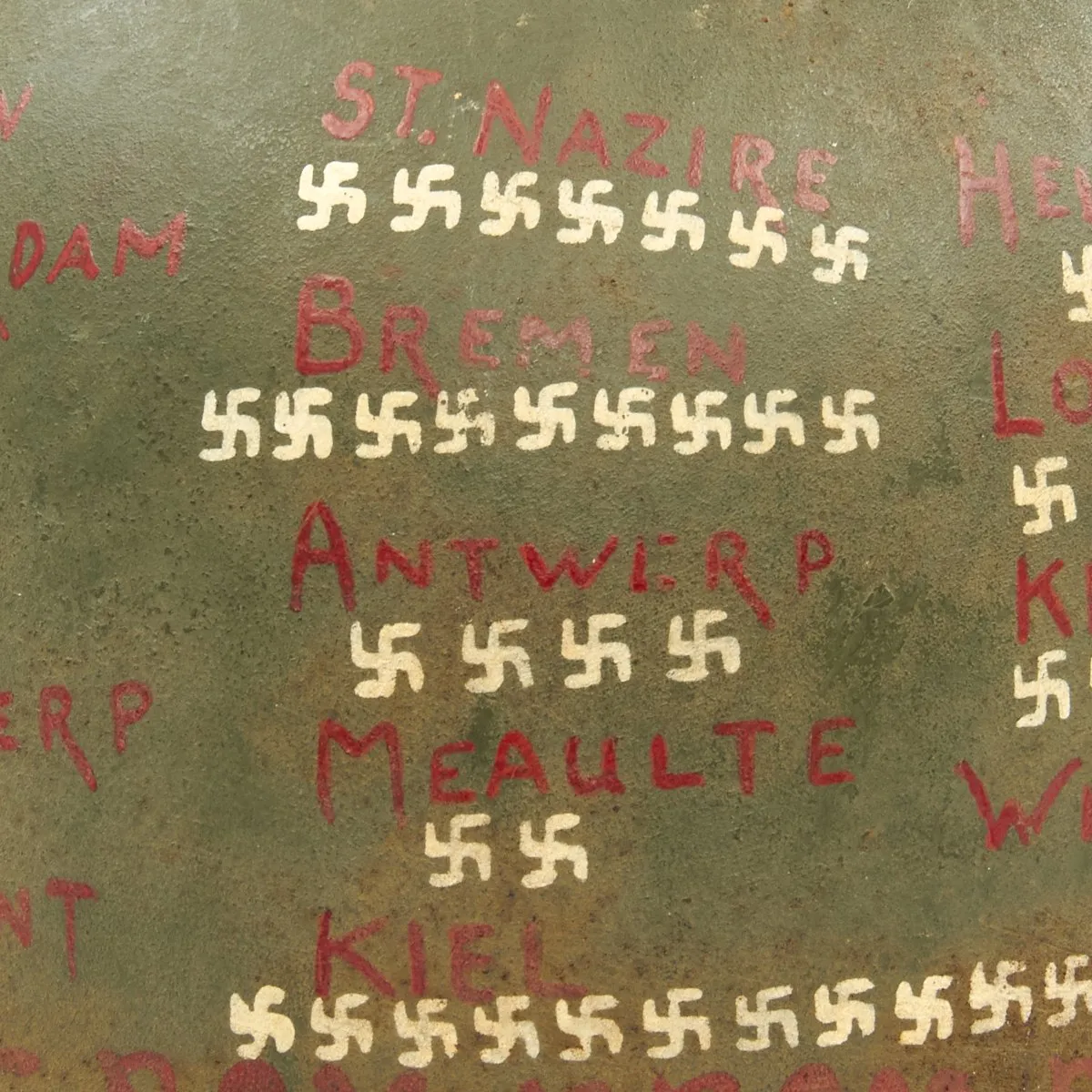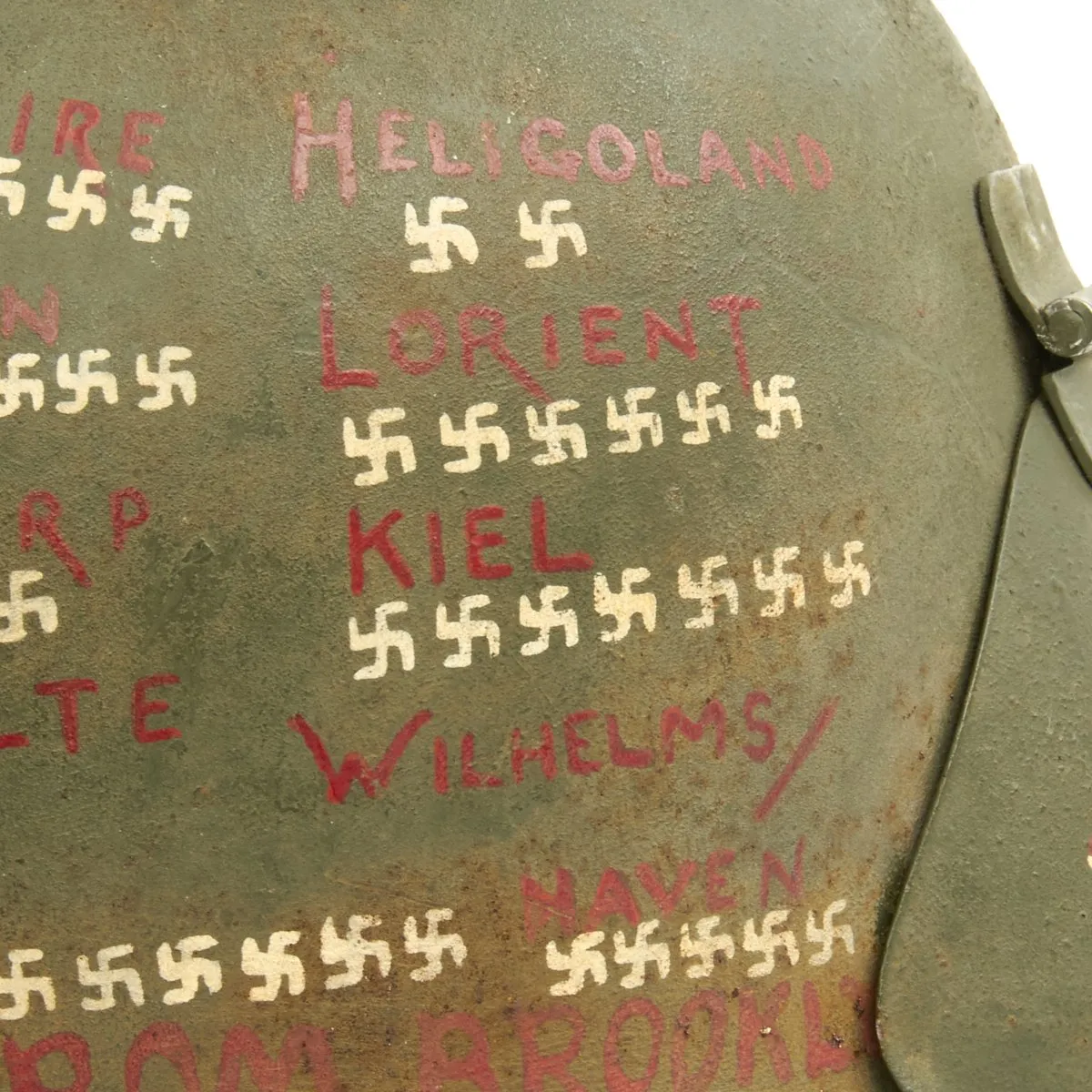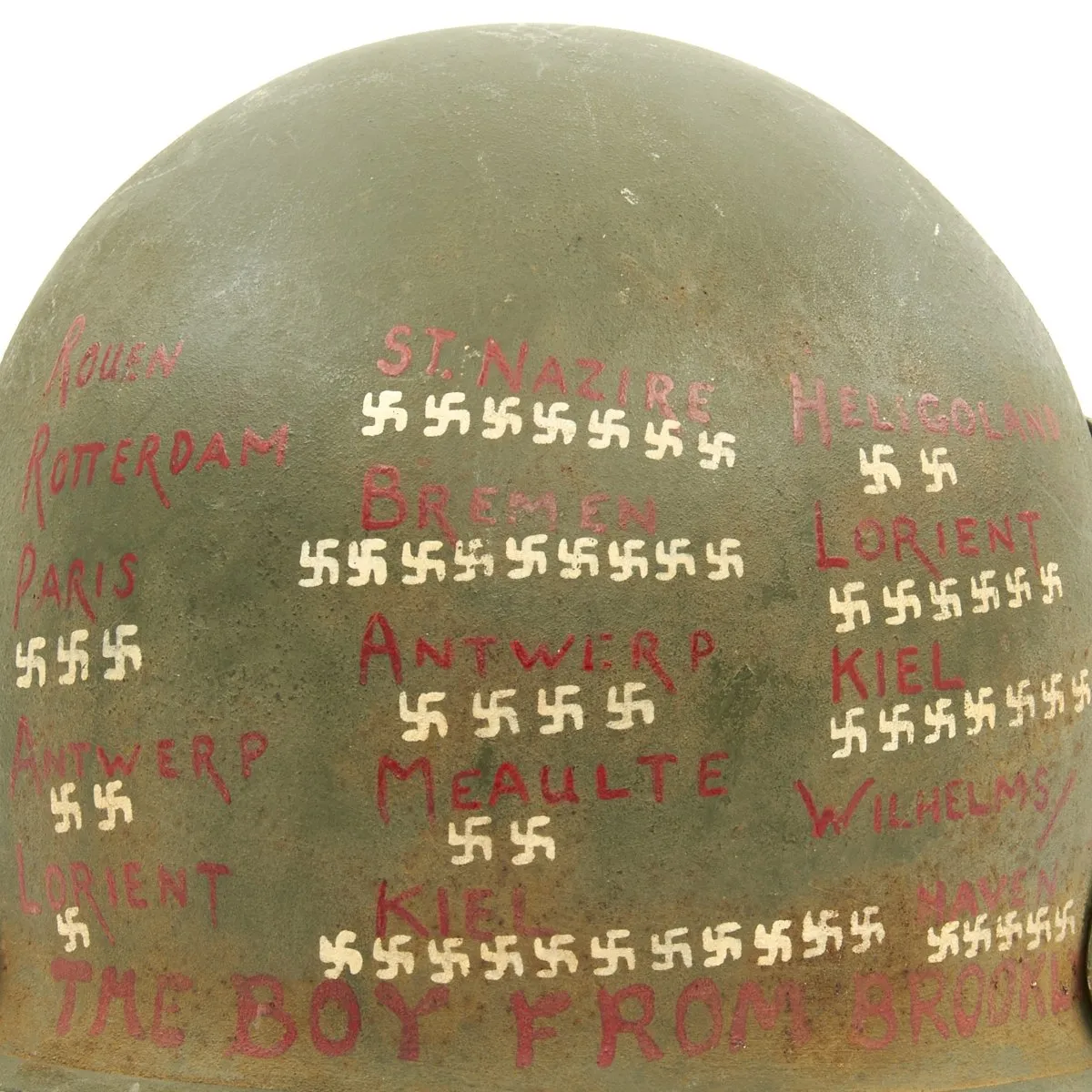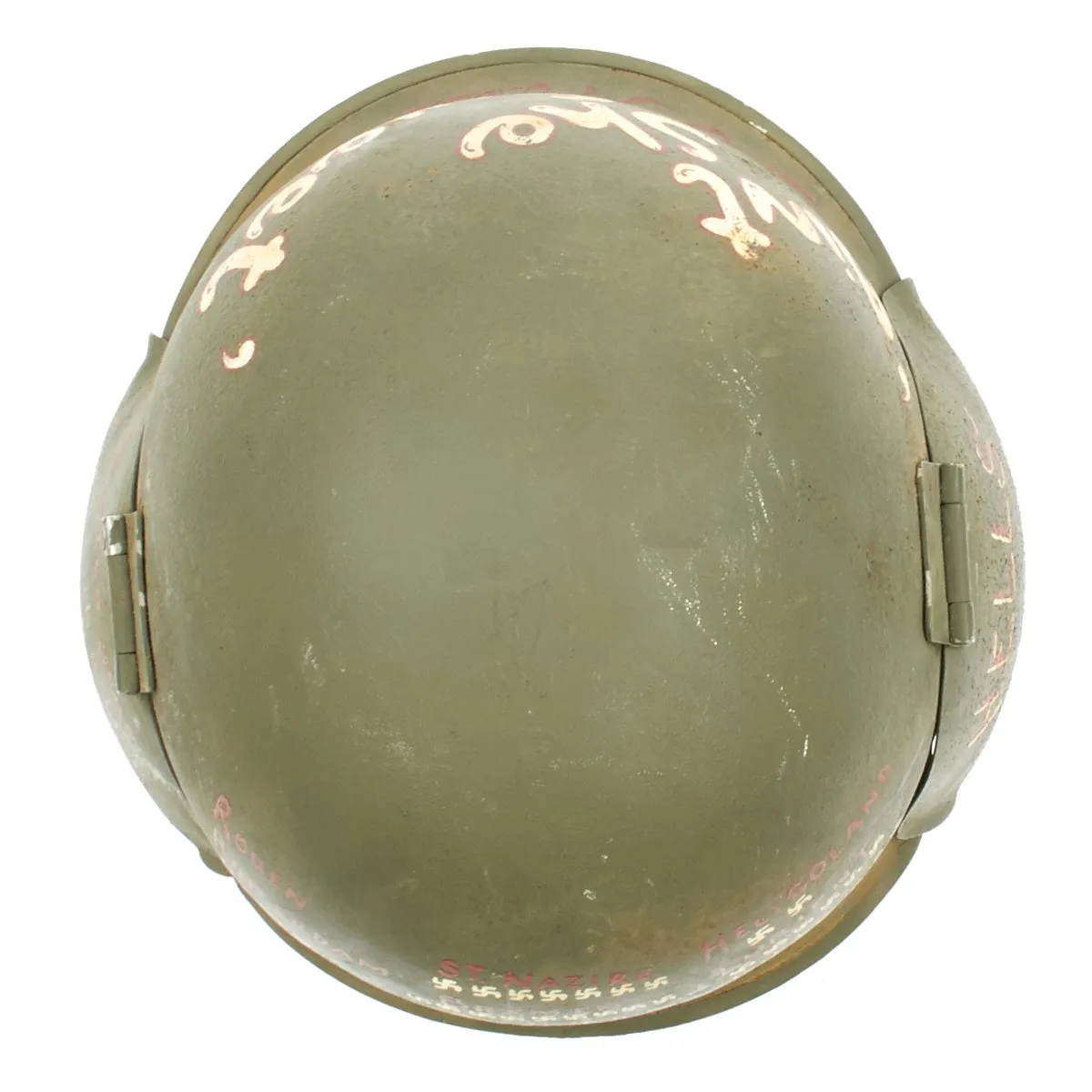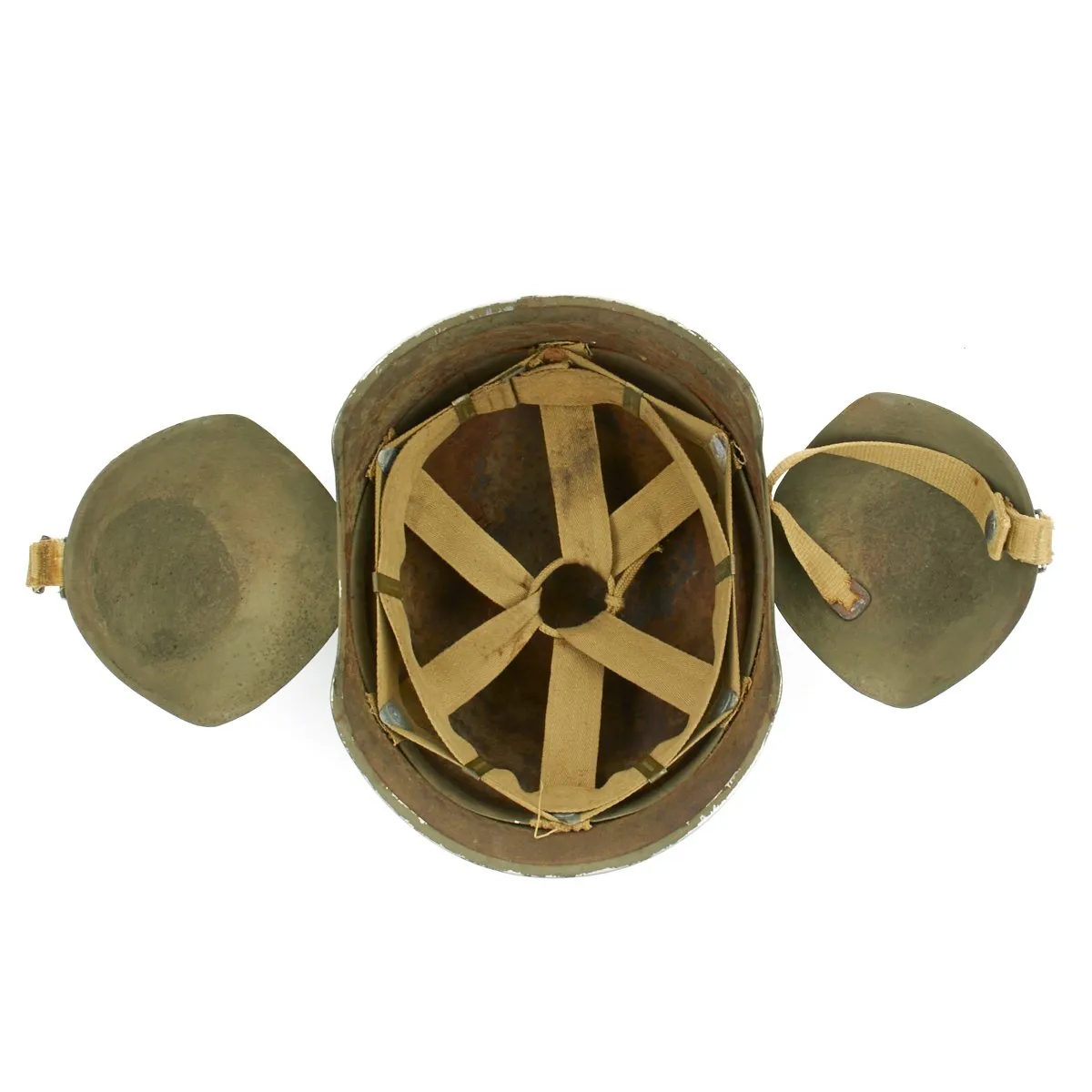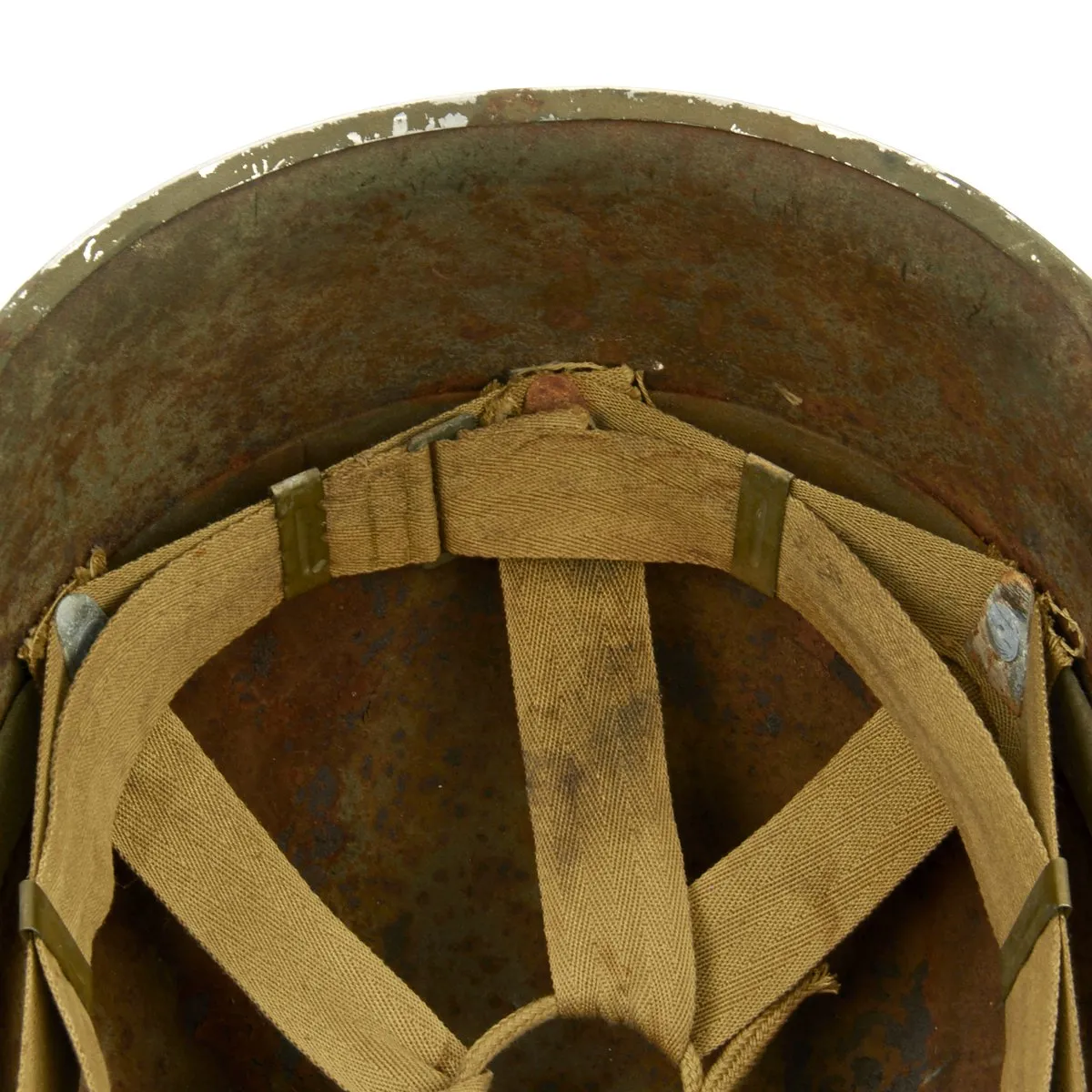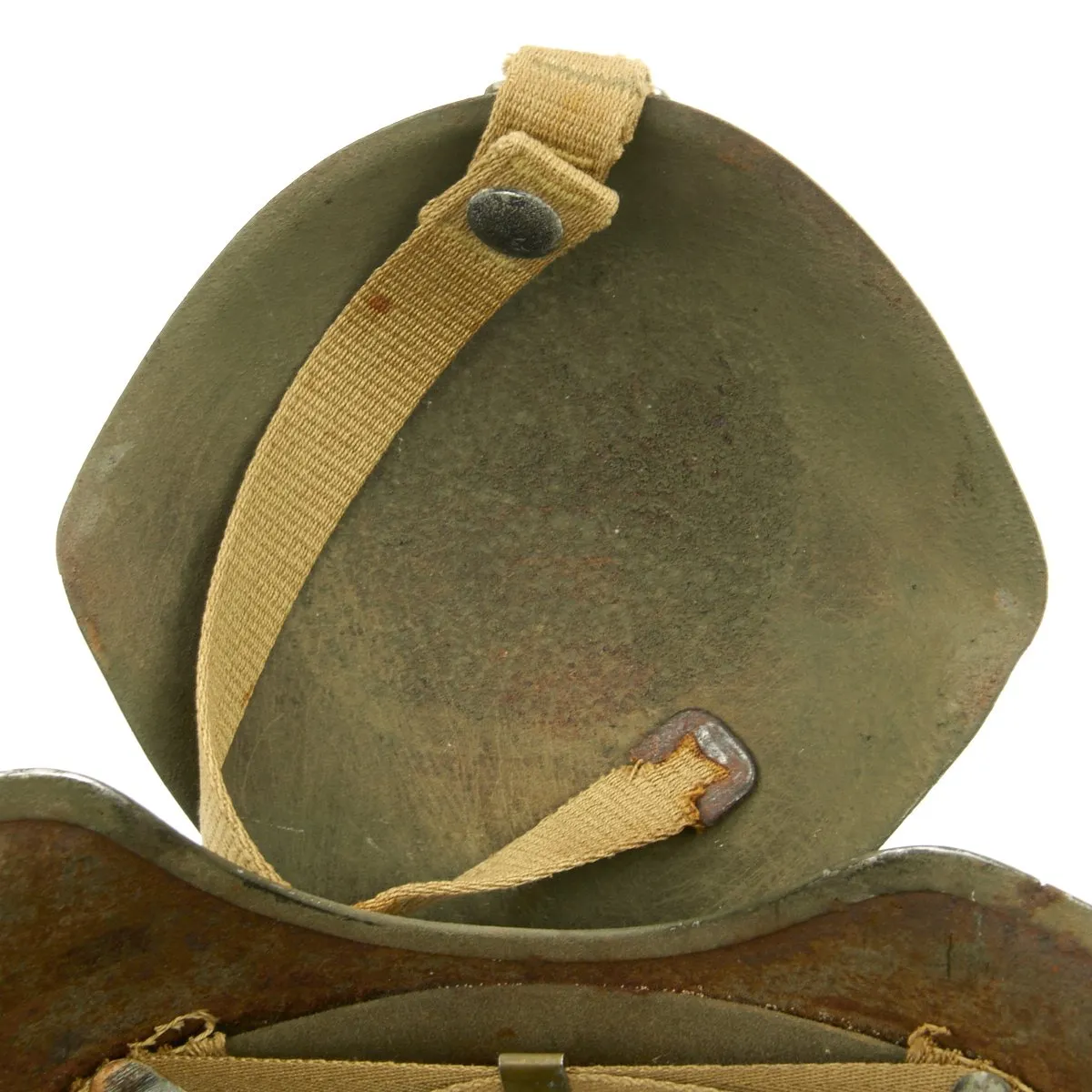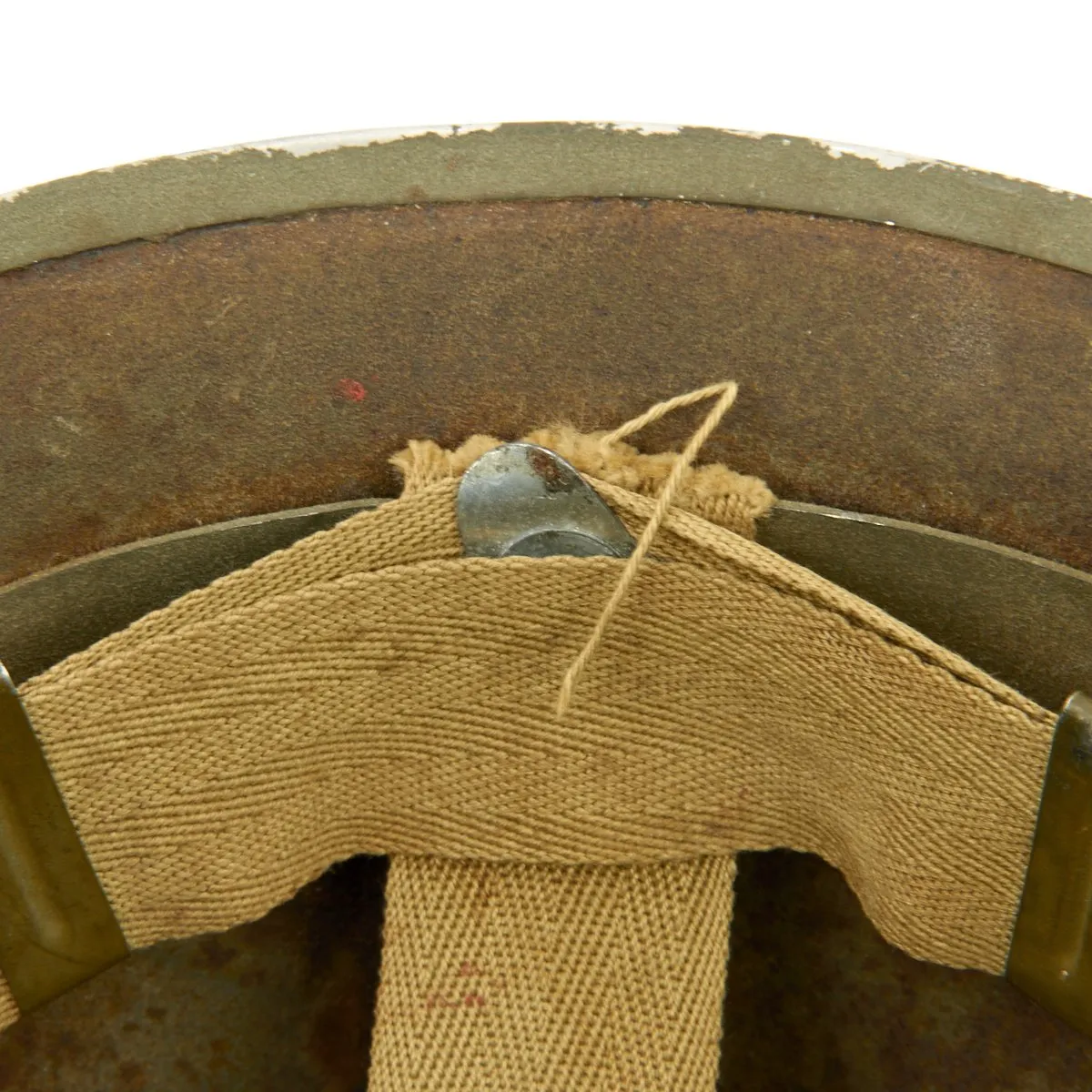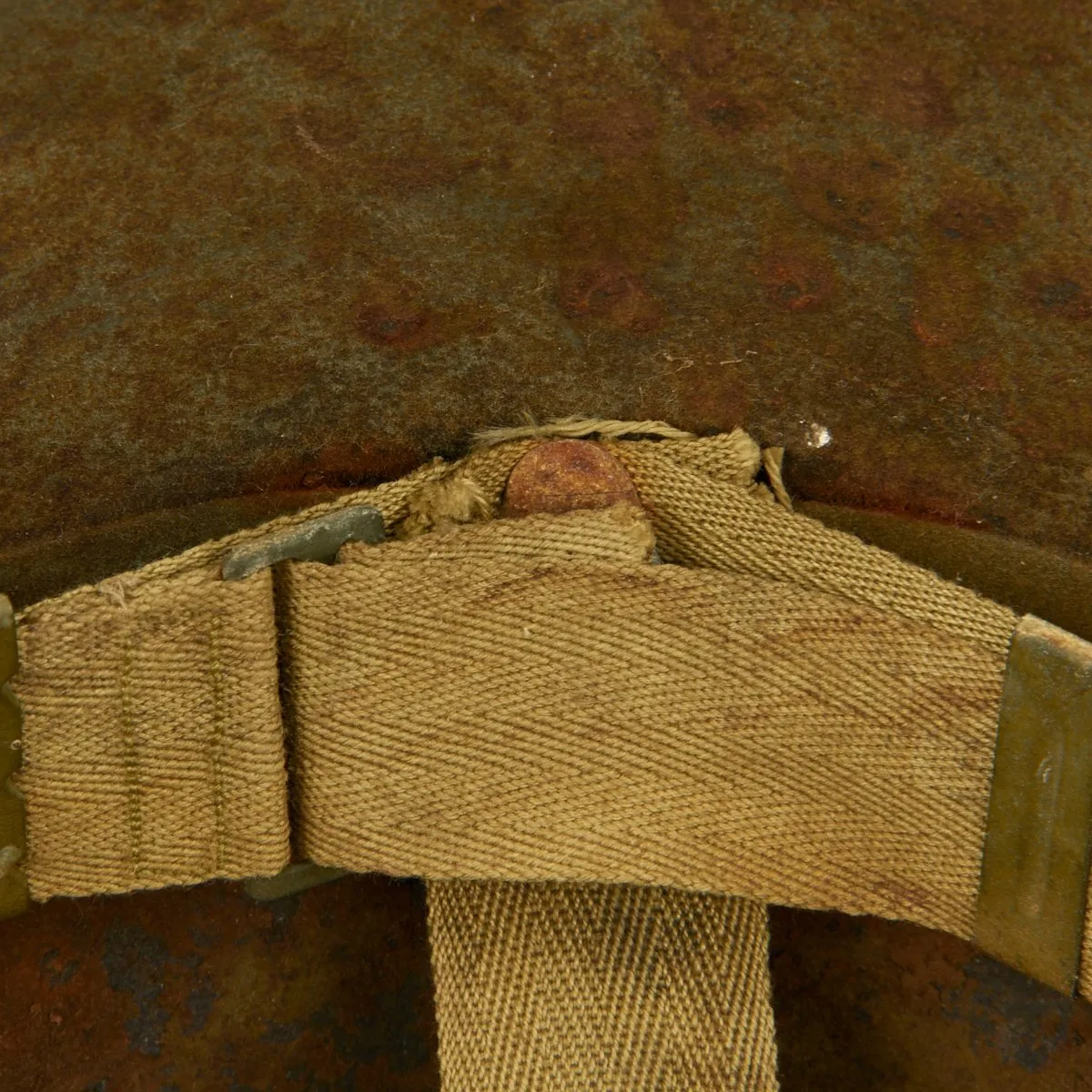Original Item: One-of-a-kind.
303rd Bomb Group CLAIMS TO FAME
- B-17F 41-24577 'Hell's Angels' first B-17 aircraft to complete 25 missions
- B-17F 41-24605 'Knock-Out Dropper' first B-17 aircraft to complete 50 and 75 missions
- B-17G 42-38050 'Thunderbird' one of the few B-17s to fly more than 100 missions
- First 8th Air Force Bomb Group to complete 300 missions
- Flew more missions than any other 8th Air Force Bomb Group.
This is an incredible genuine 303rd Bomb Group hand painted USAAF WWII issue M3 Flak Helmet. World War Two American bomber crews in the skies over Europe needed something more than their leather flying helmets to provide them with shrapnel injuries, however it took a surprisingly long time for a new helmet to be developed and deployed to meet that need. Not until December of 1943 did the M3 reach the ETO, it was the first of three versions of the American flak helmet. One of the most notable aspects of the M3 is its M1 profile; it's like the steel pot, but with hinged armored ear cups that were used to accommodate the headsets worn by the aircrews. This example is offered in very good condition, complete with the suspension liner, chinstrap. There is a bit of oxidation, expected on a helmet of this age, and some wear to the canvas, but overall this is a great example.
However, the most interesting aspect of this wonderful is the wartime applied hand painted art. The front of the helmet is painted in the same fashion as the nose art on the 303rd Bombardment Group "Hell's Angles" Boeing B-17 Flying Fortress AIN'T SHE SWEET. The brim reads 50 Missions.The left ear flap has a nude blond pinup girl riding a falling bomb marked 303 with the phrase "Shorten your tour with a trip to the Ruhr". The right ear flap reads HELLS ANGELS 303 BG.
The reverse of the helmet on the rim reads THE BOY FROM BROOKLYN has dozens of red bombing runs (targets) location names with white swass. These swass could represent kills (shot down German planes) as this helmet would have been worn by a gunner or more likely due to the number they could represent how many bombs runs over each location. The locations are as follows:
Rotterdam
Paris
(3 Swass)
Antwerp
(2 Swass)
Lorient
(1 Swas)
St. NSDAPere
(7 Swass)
The 303d Bombardment Group was activated in February 1942 as a Boeing B-17 Flying Fortress heavy bomber group at Pendleton Field, Oregon and assigned the 358th, 359th and 360th Bombardment Squadrons and the 31st Reconnaissance Squadron It moved to Gowen Field, Idaho, where its 31st Reconnaissance Squadron was replaced by the 38th Reconnaissance Squadron, which had lost most of its B-17s in the attack on Pearl Harbor. The group deployed to Southern California to fly antisubmarine patrols over the Pacific. The group completed training in southwest by August 1942. The ground echelon departed Biggs Field, Texas in August 1942, arriving at Fort Dix on 24 August. It sailed aboard the RMS Queen Mary and arrived in Great Britain on 10 September. The air echelon flew through Kellogg Field, Michigan and Dow Field, Maine before ferrying its planes across the Atlantic.
Combat in Europe
Due to the haste to move heavy bombers to Europe, the group was insufficiently trained for combat and it continued to train in England until it entered combat on 17 November 1942 in a strike against Saint-Nazaire, but returned without striking, having been unable to locate its target. It attacked Saint-Nazaire the following day, although its intended target was La Pallice. Its initial raids were on airfields, railroads and submarine pens in France. As one of only four Flying Fortress groups in VIII Bomber Command during late 1942 and early 1943, the 303d participated in the development of the tactics that would be used throughout the air campaign against Germany.
In 1943, the group began flying missions to Germany, participating in the first attack by American heavy bombers on a target in Germany, a raid on the submarine yards at Wilhelmshaven on 27 January 1943. From that time, it concentrated primarily on strategic bombardment of German industry, marshalling yards, and other strategic targets, including the ball bearing plants at Schweinfurt, shipyards at Bremen and an aircraft engine factory at Hamburg.
The 303d received a Distinguished Unit Citation when adverse weather on 11 January 1944 prevented its fighter cover from joining the group, exposing it to continuous attacks by Luftwaffe fighters. Despite this opposition, the unit successfully struck an aircraft assembly plant at Oschersleben.
Although a strategic bombing unit, the squadron was diverted on occasion to close air support and interdiction for ground forces. It attacked gun emplacements and bridges in the Pas-de-Calais during Operation Overlord, the invasion of Normandy, in June 1944; bombed enemy troops during Operation Cobra, the breakout at Saint Lo, and during the Battle of the Bulge. It bombed military installations near Wesel during Operation Lumberjack, the Allied assault across the Rhine. Its last combat mission was an attack on 25 April 1945 against an armament factory at Pilsen (now Plzeň).
Following VE Day in May 1945 the 303d Group was reassigned to the North African Division, Air Transport Command and moved to Casablanca Airfield, French Morocco to use its B-17 bombers as transports, ferrying personnel from France to Morocco. However, the two B-17 groups moved to Casablanca proved surplus to Air Transport Command's needs and the squadron was inactivated in late July 1945 and its planes ferried back to the United States.
During the War, the 303d flew 364 missions, more than any other Eighth Air Force B-17 group, and one group Fort, "Hell's Angels", was the first to complete 25 missions, while another, "Knock Out Dropper", was the first to complete 50 and 75 missions. Only one other group delivered more bomb tonnage than the 303d. However, the group lost 165 planes, more than five times its authorized strength of 30 B-17s.
Medals of Honor
On 20 December 1943 one of the group's planes, nicknamed the "Jersey Bounce" was hit by flak and lost two engines while attacking the target, causing the Fort to drop behind the formation. Two 20 millimeter cannon shells exploded in the radio compartment, injuring Technical Sergeant Forrest L. Vosler, the radio operator-gunner. The first injuring him in the legs and thighs and the second striking is chest and also nearly blinding him. Sergeant Vosler continued to fire his gun at attacking fighters. He began to lapse in and out of consciousness, but (working by feel) repaired the radio so that emergency transmissions could be made. When the B-17 ditched, he managed to climb on the wing unaided and assist the badly wounded tail gunner until he could be loaded into one of the plane's dinghies. Sergeant Vosler was awarded the Medal of Honor for his actions.
Flying through intense flak on a mission against Bremen-Vegesack on 18 March 1943, in which bombing was to be done by squadrons, 1st Lieutenant Jack W. Mathis, was bombardier on the lead aircraft of the group's 359th Squadron. Less than a minute before bomb release, he was knocked nine feet back from his bombsight. Although Lt Mathis was mortally wounded, he returned to his position to release his bombs and ensure the squadron struck its target, dying as he toggled the bomb release. For this action, Lt Mathis was awarded the Medal of Honor
Capture of "Wulfe Hound"
A B-17F from the group's 360th Bombardment Squadron, nicknamed "Wulfe Hound"[note 3]) was the first Flying Fortress to be captured by the Luftwaffe. On December 12, 1942 (the group's sixth mission, after attacking railroad marshaling yards in the Sotteville-lès-Rouen area of France, "Wulfe Hound" was damaged by Focke-Wulf Fw 190 fighters. The damage forced the pilot, First Lieutenant Paul F. Flickenger to make a wheels-up landing in a hayfield near Melun (60 miles southeast of Paris), with the ball turret guns pointing downward. Eight of the crew were captured but Lieutenants Gilbert T Schowalter (navigator) and Jack E. Williams (co-pilot) were able to escape and evade.
Luftwaffe personnel transported the B-17 to the Leeuwarden Airfield in the Netherlands, where repairs were made and the B-17 put in flyable condition. The damaged ball turret was never repaired. It was painted with German Balkenkreuz and assigned Stammkennzeichen alphabetic code DL XC with yellow paint on the undersurfaces. It was carefully examined and tested at the Luftwaffe Test and Evaluation Center at Rechlin-Lärz Airfield. Wulfe Hound was first flown by the Germans on 17 March 1943, followed by more testing and development of fighter tactics against B-17s.
It was then transferred to Kampfgeschwader 200 special operations wing at Rangesdorf, Germany on 11 September 1943. It then took part in training and highly secretive clandestine missions between May and June 1944. On 20 April 1945 the aircraft was caught in an American air-raid on Oranienburg Airfield and was partially destroyed.




